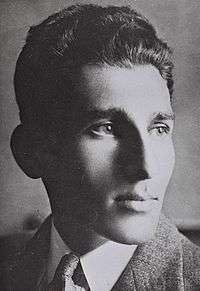Lehi (militant group)
Lehi (Hebrew pronunciation: [ˈleχi]; Hebrew: לח"י – לוחמי חרות ישראל Lohamei Herut Israel – Lehi, "Fighters for the Freedom of Israel – Lehi"), often known pejoratively as the Stern Gang,[2][3][4][5] was a Zionist paramilitary organization founded by Avraham ("Yair") Stern in Mandatory Palestine.[6][7] Its avowed aim was to evict the British authorities from Palestine by resort to force, allowing unrestricted immigration of Jews and the formation of a Jewish state, a "new totalitarian Hebrew republic".[8] It was initially called the National Military Organization in Israel,[9] upon being founded in August 1940, but was renamed Lehi one month later.[10] The group referred to its members as terrorists[11] and admitted to having carried out terrorist attacks.[12][13][14]
| לח"י Lehi | |
|---|---|
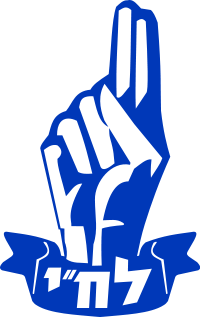 | |
| Active | 1940–1948 |
| Disbanded | 28 May 1948 |
| Country | Yishuv, Mandatory Palestine Israel |
| Type | Paramilitary (pre-independence) Unified armed forces (post-independence) |
| Engagements | World War II Jewish Revolt in Palestine Palestine Civil War 1948 Arab–Israeli War |
| Commanders | |
| Notable commanders | Avraham Stern, Yitzhak Shamir, Nathan Yellin-Mor |
Lehi split from the Irgun militant group in 1940 in order to continue fighting the British during World War II. Lehi initially sought an alliance with Fascist Italy and Nazi Germany, offering to fight alongside them against the British in return for the transfer of all Jews from Nazi-occupied Europe to Palestine.[15] Believing that Nazi Germany was a lesser enemy of the Jews than Britain, Lehi twice attempted to form an alliance with the Nazis.[15] During World War II, it declared that it would establish a Jewish state based upon "nationalist and totalitarian principles".[15][16] After Stern's death in 1942, the new leadership of Lehi began to move it towards support for Joseph Stalin's Soviet Union.[9] In 1944, Lehi officially declared its support for National Bolshevism.[17] It said that its National Bolshevism involved an amalgamation of left-wing and right-wing political elements – Stern said Lehi incorporated elements of both the left and the right[15] – however this change was unpopular and Lehi began to lose support as a result.[18]
Lehi and the Irgun were jointly responsible for the massacre in Deir Yassin. Lehi assassinated Lord Moyne, British Minister Resident in the Middle East, and made many other attacks on the British in Palestine.[19] On 29 May 1948, the government of Israel, having inducted its activist members into the Israel Defense Forces, formally disbanded Lehi, though some of its members carried out one more terrorist act, the assassination of Folke Bernadotte some months later,[20] an act condemned by Bernadotte's replacement as mediator, Ralph Bunche.[21] After the assassination, the new Israeli government declared Lehi a terrorist organization, arresting some 200 members and convicting some of the leaders.[22] Just before the first Israeli elections in January 1949, a general amnesty to Lehi members was granted by the government.[22] In 1980, Israel instituted a military decoration, an "award for activity in the struggle for the establishment of Israel", the Lehi ribbon.[23] Former Lehi leader Yitzhak Shamir became Prime Minister of Israel in 1983.
Founding of Lehi
Lehi was created in August 1940 by Avraham Stern.[10] Stern had been a member of the Irgun (Irgun Tsvai Leumi – "National Military Organization") high command. Zeev Jabotinsky, then the Irgun's supreme commander, had decided that diplomacy and working with Britain would best serve the Zionist cause. World War II was in progress, and Britain was fighting Nazi Germany. The Irgun suspended its underground military activities against the British for the duration of the war.
Stern argued that the time for Zionist diplomacy was over and that it was time for armed struggle against the British. Like other Zionists, he objected to the White Paper of 1939, which restricted both Jewish immigration and Jewish land purchases in Palestine. For Stern, "no difference existed between Hitler and Chamberlain, between Dachau or Buchenwald and sealing the gates of Eretz Israel."[24]
Stern wanted to open Palestine to all Jewish refugees from Europe, and considered this as by far the most important issue of the day. Britain would not allow this. Therefore, he concluded, the Yishuv (Jews of Palestine) should fight the British rather than support them in the war. When the Irgun made a truce with the British, Stern left the Irgun to form his own group, which he called Irgun Tsvai Leumi B'Yisrael ("National Military Organization in Israel"), later Lohamei Herut Israel ("Fighters for the Freedom of Israel"). In September 1940, the organization was officially named "Lehi", the Hebrew acronym of the latter name.[10]
Stern and his followers believed that dying for the "foreign occupier" who was obstructing the creation of the Jewish State was useless. They differentiated between "enemies of the Jewish people" (the British) and "Jew haters" (the Nazis), believing that the former needed to be defeated and the latter manipulated.[25]
In 1940, the idea of the Final Solution was still "unthinkable", and Stern believed that Hitler wanted to make Germany judenrein through emigration, as opposed to extermination.[24][26] In December 1940, Lehi even contacted Germany with a proposal to aid German conquest in the Middle East in return for recognition of a Jewish state open to unlimited immigration.[24]
Goals and methods
Lehi had three main goals:
- To bring together all those interested in liberation (that is, those willing to join in active fighting against the British).
- To appear before the world as the only active Jewish military organization.
- To take over Eretz Yisrael (the Land of Israel) by armed force.[28]
Lehi believed in its early years that its goals would be achieved by finding a strong international ally that would expel the British from Palestine, in return for Jewish military help; this would require the creation of a broad and organised military force "demonstrating its desire for freedom through military operations."[29]
Lehi also referred to themselves as 'terrorists' and may have been one of the last organizations to do so.[11]
An article titled "Terror" in the Lehi underground newspaper He Khazit (The Front) argued as follows:
Neither Jewish ethics nor Jewish tradition can disqualify terrorism as a means of combat. We are very far from having any moral qualms as far as our national war goes. We have before us the command of the Torah, whose morality surpasses that of any other body of laws in the world: "Ye shall blot them out to the last man."
But first and foremost, terrorism is for us a part of the political battle being conducted under the present circumstances, and it has a great part to play: speaking in a clear voice to the whole world, as well as to our wretched brethren outside this land, it proclaims our war against the occupier.
We are particularly far from this sort of hesitation in regard to an enemy whose moral perversion is admitted by all.[14]
The article described the goals of terror:
Yitzhak Shamir, one of the three leaders of Lehi after Avraham Stern's assassination, argued for the legitimacy of Lehi's actions:
There are those who say that to kill [T.G.] Martin [a CID sergeant who had recognised Shamir in a lineup] is terrorism, but to attack an army camp is guerrilla warfare and to bomb civilians is professional warfare. But I think it is the same from the moral point of view. Is it better to drop an atomic bomb on a city than to kill a handful of persons? I don’t think so. But nobody says that President Truman was a terrorist. All the men we went for individually – Wilkin, Martin, MacMichael and others – were personally interested in succeeding in the fight against us.
So it was more efficient and more moral to go for selected targets. In any case, it was the only way we could operate, because we were so small. For us it was not a question of the professional honor of a soldier, it was the question of an idea, an aim that had to be achieved. We were aiming at a political goal. There are many examples of what we did to be found in the Bible – Gideon and Samson, for instance. This had an influence on our thinking. And we also learned from the history of other peoples who fought for their freedom – the Russian and Irish revolutionaries, Giuseppe Garibaldi and Josip Broz Tito.[30]
18 Principles of Rebirth
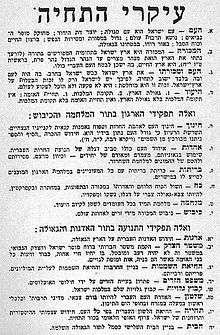
Avraham Stern laid out the ideology of Lehi in the essay 18 Principles of Rebirth:[31]
- THE NATION: The Jewish people is a covenanted people, the originator of monotheism, formulator of the prophetic teachings, standard bearer of human culture, guardian of glorious patrimony. The Jewish people is schooled in self-sacrifice and suffering; its vision, survivability and faith in redemption are indestructible.
- THE HOMELAND: The homeland in the Land of Israel within the borders delineated in the Bible ("To your descendants, I shall give this land, from the River of Egypt to the great Euphrates River." Genesis 15:18) This is the land of the living, where the entire nation shall live in safety.
- THE NATION AND ITS LAND: Israel conquered the land with the sword. There it became a great nation and only there it will be reborn. Hence Israel alone has a right to that land. This is an absolute right. It has never expired and never will.
- THE GOALS:
- Redemption of the land.
- Establishment of sovereignty.
- Revival of the nation.
- There is no sovereignty without the redemption of the land, and there is no national revival without sovereignty.
- These are the goals of the organization during the period of war and conquest:
- EDUCATION: Educate the nation to love freedom and zealously guard Israel's eternal patrimony. Inculcate the idea that the nation is master to its own fate. Revive the doctrine that "The sword and the book came bound together from heaven." (Midrash Vayikra Rabba 35:8)
- UNITY: The unification of the entire nation around the banner of the Hebrew freedom movement. The use of the genius, status and resources of individuals and the channeling of the energy, devotion and revolutionary fervour of the masses for the war of liberation.
- PACTS: Make pacts with all those who are willing to help the struggle of the organization and provide direct support.
- FORCE: Consolidate and increase the fighting force in the homeland and in the Diaspora, in the underground and in the barracks, to become the Hebrew army of liberation with its flag, arms, and commanders.
- WAR: Constant war against those who stand in the way of fulfilling the goals.
- CONQUEST: The conquest of the homeland from foreign rule and its eternal possession.
- These are the tasks of the movement during the period of sovereignty and redemption:
- SOVEREIGNTY: Renewal of Hebrew sovereignty over the redeemed land.
- RULE OF JUSTICE: The establishment of a social order in the spirit of Jewish morality and prophetic justice. Under such an order no one will go hungry or unemployed. All will live in harmony, mutual respect and friendship as an example to the world.
- REVIVING THE WILDERNESS: Build the ruins and revive the wilderness for mass immigration and population increase.
- ALIENS: Solve the problem of alien population [i.e. the Arab inhabitants of Palestine] by exchange of population.
- INGATHERING OF THE EXILES: Total in-gathering of the exiles to their sovereign state.
- POWER: The Hebrew nation shall become a first-rate military, political, cultural and economical entity in the Middle East and around the Mediterranean Sea.
- REVIVAL: The revival of the Hebrew language as a spoken language by the entire nation, the renewal of the historical and spiritual might of Israel. The purification of the national character in the fire of revival.
- THE TEMPLE: The building of the Third Temple as a symbol of the new era of total redemption.
Relationship with fascism and socialism
Unlike the left-wing Haganah and right-wing Irgun, Lehi members were not a homogeneous collective with a single political, religious, or economic ideology. They were a combination of militants united by the goal of liberating the land of Israel from British rule. Most Lehi leaders defined their organization as an anti-imperialism movement and stated that their opposition to British colonial rule in Palestine was not based on a particular policy but rather on the presence of a foreign power over the homeland of the Jewish people. Avraham Stern defined the British Mandate as "foreign rule" regardless of British policies and took a radical position against such imperialism even if it were to be benevolent.[32]
In the early years of the state of Israel Lehi veterans could be found supporting nearly all political parties and some Lehi leaders founded a left-wing political party called the Fighters' List with Natan Yellin-Mor as its head. The party took part in the elections in January 1949 and won a single parliamentary seat. A number of Lehi veterans established the Semitic Action movement in 1956 which sought the creation of a regional federation encompassing Israel and its Arab neighbors[33][34] on the basis of an anti-colonialist alliance with other indigenous inhabitants of the Middle East.[35]
Some writers have stated that Lehi's true goals were the creation of a totalitarian state.[36] Perlinger and Weinberg write that the organisation's ideology placed "its world view in the quasi-fascist radical Right, which is characterised by xenophobia, a national egotism that completely subordinates the individual to the needs of the nation, anti-liberalism, total denial of democracy and a highly centralised government."[37] Perliger and Weinberg state that most Lehi members were admirers of the Italian Fascist movement.[29] According to Kaplan and Penslar, Lehi's ideology was a mix of fascist and communist thought combined with racism and universalism.[38]
Others counter these claims. They note that when Lehi founder Avraham Stern went to study in fascist Italy, he refused to join the Gruppo Universitario Fascista for foreign students, even though members got large reductions in tuition.[39]
Racism
According to Yaacov Shavit professor at the Department of Jewish History, Tel Aviv University articles in publications by Lehi contained references to a Jewish "master race", contrasting the Jews with Arabs who were seen as a "nation of slaves"[40] Sasha Polakow-Suransky writes about Lehi "Lehi was also unabashedly racist towards Arabs. Their publications described Jews as a master race and Arabs as a slave race." Lehi advocated mass expulsion of all Arabs from Palestine and Transjordan[41] or even their physical annihilation.[42]
Evolution and tactics of the organization
Many Lehi combatants had received military training. Some had attended the state military academy in Civitavecchia, in Fascist Italy.[43] Others received military training from instructors of the Polish Armed Forces in 1938–1939. This training was conducted in Trochenbrod (Zofiówka) in Wołyń Voivodeship, Podębin near Łódź, and the forests around Andrychów. They were taught how to use explosives. One of them reported later: "Poles treated terrorism as a science. We have mastered mathematical principles of demolishing constructions made of concrete, iron, wood, bricks and dirt."[43]
The group was initially unsuccessful. Early attempts to raise funds through criminal activities, including a bank robbery in Tel Aviv in 1940 and another robbery on 9 January 1942 in which Jewish passers-by were killed, brought about the temporary collapse of the group. An attempt to assassinate the head of the British secret police in Lod in which three police personnel were killed, two Jewish and one British, elicited a severe response from the British and Jewish establishments who collaborated against Lehi.[44]
.jpg)
Stern's group was seen as a terrorist organisation by the British authorities, who instructed the Defence Security Office (the colonial branch of MI5) to track down its leaders. In 1942, Stern, after he was arrested, was shot dead in disputed circumstances by Inspector Geoffrey J. Morton of the CID.[45] The arrest of several other members led momentarily to the group's eclipse, until it was revived after the September 1942 escape of two of its leaders, Yitzhak Shamir and Eliyahu Giladi, aided by two other escapees Natan Yellin-Mor (Friedman) and Israel Eldad (Sheib). (Giladi was later killed by Lehi under circumstances that remain mysterious.)[44] Shamir's codename was "Michael", a reference to one of Shamir's heroes, Michael Collins. Lehi was guided by spiritual and philosophical leaders such as Uri Zvi Greenberg and Israel Eldad. After the killing of Giladi, the organization was led by a triumvirate of Eldad, Shamir, and Yellin-Mor.
Lehi adopted a non-socialist platform of anti-imperialist ideology. It viewed the continued British rule of Palestine as a violation of the Mandate's provision generally, and its restrictions on Jewish immigration to be an intolerable breach of international law. However they also targeted Jews whom they regarded as traitors, and during the 1948 Arab-Israeli War they joined in operations with the Haganah and Irgun against Arab targets, for example Deir Yassin.
According to a compilation by Nachman Ben-Yehuda, Lehi was responsible for 42 assassinations, more than twice as many as the Irgun and Haganah combined during the same period. Of those Lehi assassinations that Ben-Yehuda classified as political, more than half the victims were Jews.[46]
Lehi also rejected the authority of the Jewish Agency for Israel and related organizations, operating entirely on its own throughout nearly all of its existence.
Lehi prisoners captured by the British generally refused to employ lawyers in their defense. The defendants would conduct their own defense, and would deny the right of the military court to try them, saying that in accordance with the Hague Convention they should be accorded the status of prisoners of war. For the same reason, Lehi prisoners refused to plead for amnesty, even when it was clear that this would have spared them the death penalty.[47] Moshe Barazani, a Lehi member, and Meir Feinstein, an Irgun member, took their own lives in prison with a grenade smuggled inside an orange so the British could not hang them.[48]
Wartime contacts with Italy and Nazi Germany
Italy
In mid-1940, Stern became convinced that the Italians were interested in the establishment of a fascist Jewish state in Palestine.[49] He conducted negotiations, he thought, with the Italians via an intermediary Moshe Rotstein, and drew up a document that became known as the "Jerusalem Agreement".[50][51] In exchange for Italy's recognition of, and aid in obtaining, Jewish sovereignty over Palestine, Stern promised that Zionism would come under the aegis of Italian fascism, with Haifa as its base, and the Old City of Jerusalem under Vatican control, except for the Jewish quarter.[52] In Heller's words, Stern's proposal would "turn the 'Kingdom of Israel' into a satellite of the Axis powers."[53]
However, the "intermediary" Rotstein was in fact an agent of the Irgun, conducting a sting operation under the direction of the Irgun intelligence leader in Haifa, Israel Pritzker, in cooperation with the British.[54] Secret British documents about the affair were uncovered by historian Eldad Harouvi (now director of the Palmach Archives) and confirmed by former Irgun intelligence officer Yitzhak Berman.[54] When Rotstein's role later became clear, Lehi sentenced him to death and assigned Yaacov Eliav to kill him, but the assassination never took place.[51][55] However, Pritzker was killed by Lehi in 1943.[51]
Nazi Germany
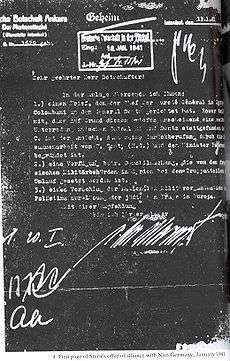
Late in 1940, Lehi, having identified a common interest between the intentions of the new German order and Jewish national aspirations, proposed forming an alliance in World War II with Nazi Germany.[15] The organization offered cooperation in the following terms: Lehi would rebel against the British, while Germany would recognize an independent Jewish state in Palestine/Eretz Israel, and all Jews leaving their homes in Europe, by their own will or because of government injunctions, could enter Palestine with no restriction of numbers.[25] Late in 1940, Lehi representative Naftali Lubenchik went to Beirut to meet German official Werner Otto von Hentig. The Lehi documents outlined that its rule would be authoritarian and indicated similarities between the organization and Nazis.[25] Israel Eldad, one of the leading members of Lehi, wrote about Hitler "it is not Hitler who is the hater of the kingdom of Israel and the return to Zion, it is not Hitler who subjects us to the cruel fate of falling a second and a third time into Hitler's hands, but the British."[56]
Stern also proposed recruiting some 40,000 Jews from occupied Europe to invade Palestine with German support to oust the British.[15] On 11 January 1941, Vice Admiral Ralf von der Marwitz, the German Naval attaché in Turkey, filed a report (the "Ankara document") conveying an offer by Lehi to "actively take part in the war on Germany's side" in return for German support for "the establishment of the historic Jewish state on a national and totalitarian basis, bound by a treaty with the German Reich."[50][57][58]
According to Yellin-Mor:
Lubenchik did not take along any written memorandum for the German representatives. Had there been a need for one, he would have formulated it on the spot, since he was familiar with the episode of the Italian "intermediary" and with the numerous drafts connected with it. Apparently one of von Hentig's secretaries noted down the essence of the proposal in his own words.[59]
According to Joseph Heller, "The memorandum arising from their conversation is an entirely authentic document, on which the stamp of the 'IZL in Israel' is clearly embossed."[60]
Von der Marwitz delivered the offer, classified as secret, to the German Ambassador in Turkey and on 21 January 1941 it was sent to Berlin. There was never any response.[61]
A second attempt to contact the Nazis was made at the end of 1941, but it was even less successful.[62] The emissary Yellin-Mor was arrested in Syria before he could carry out his mission.[63]
This proposed alliance with Nazi Germany cost Lehi and Stern much support.[64] The Stern Gang also had links with, and support from, the Vichy France Sûreté's Lebanese offices.[65]
Even as the full scale of Nazi atrocities became more evident in 1943, Lehi refused to accept Hitler as main foe (as opposed to Great Britain).[66]
Later history
As a group that never had over a few hundred members, Lehi relied on audacious but small-scale operations to bring their message home. They adopted the tactics of groups such as the Socialist Revolutionaries and the Combat Organization of the Polish Socialist Party in Czarist Russia,[67] and the Irish Republican Army. To this end, Lehi conducted small-scale operations such as individual assassinations of British officials (notable targets included Lord Moyne, CID detectives, and Jewish "collaborators"), and random shootings against soldiers and police officers.[68] Another strategy, adopted in 1946, was to send bombs in the mail to British politicians. Other actions included sabotaging infrastructure targets: bridges, railroads, telephone and telegraph lines, and oil refineries, as well as the use of vehicle bombs against British military, police, and administrative targets. Lehi financed its operations from private donations, extortion, and bank robbery. Its campaign of violence lasted from 1944 to 1948. Initially conducted together with the Irgun, it included a six-month suspension to avoid being targeted by the Haganah during the Hunting Season, and later operated jointly with the Haganah and Irgun under the Jewish Resistance Movement. After the Jewish Resistance Movement was dissolved, it operated independently as part of the general Jewish insurgency in Palestine.
Assassination of Lord Moyne
On 6 November 1944, Lehi assassinated Lord Moyne, the British Minister Resident in the Middle East, in Cairo. Moyne was the highest ranking British official in the region. Yitzhak Shamir claimed later that Moyne was assassinated because of his support for a Middle Eastern Arab Federation and anti-Semitic lectures in which Arabs were held to be racially superior to Jews.[69] The assassination rocked the British government, and outraged Winston Churchill, the British Prime Minister. The two assassins, Eliahu Bet-Zouri and Eliahu Hakim were captured and used their trial as a platform to make public their political propaganda. They were executed. In 1975 their bodies were returned to Israel and given a state funeral.[70] In 1982, postage stamps were issued for 20 Olei Hagardom, including Bet-Zouri and Hakim, in a souvenir sheet called "Martyrs of the struggle for Israel's independence."[71][72]
Tel Aviv car park raid
On 25 April 1946, a Lehi unit attacked a car park in Tel Aviv occupied by the British 6th Airborne Division. Under a barrage of heavy covering fire, Lehi fighters broke into the car park, shot soldiers they encountered at close range, stole rifles from arms racks, laid mines to cover the retreat, and withdrew. Seven soldiers were killed in the attack, which caused widespread outrage among the British security forces in Palestine. It resulted in retaliatory anti-Jewish violence by British troops and a punitive curfew imposed on Tel Aviv's roads and a closure of places of entertainment in the city by the British Army.[68]
British police station in Haifa
On 12 January 1947, Lehi members drove a truckload of explosives into a British police station in Haifa killing four and injuring 140, in what has been called 'the world's first true truck bomb'.[73]
Operations in Europe
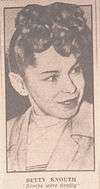
Following the bombing of the British embassy in Rome, October 1946, a series of operations against targets in the United Kingdom were launched. On 7 March 1947, Lehi's only successful operation in Britain was carried out when a Lehi bomb severely damaged the British Colonial Club, a London recreational facility for soldiers and students from Britain's colonies in Africa and the West Indies.[74] On 15 April 1947 a bomb consisting of twenty-four sticks of explosives was planted in the Colonial Office, Whitehall. It failed to explode due to a fault in the timer. Five weeks later, on 22 May, five alleged Lehi members were arrested in Paris with bomb making material including explosives of the same type as found in London. On 2 June, two Lehi members, Betty Knouth and Yaakov Levstein, were arrested crossing from Belgium to France. Envelopes addressed to British officials, with detonators, batteries and a time fuse were found in one of Knouth's suitcases. Knouth was sentenced to a year in prison, Levstein to eight months. The British Security Services identified Knouth as the person who planted the bomb in the Colonial Office. Shortly after their arrest, 21 letter bombs were intercepted addressed to senior British figures. The letters had been posted in Italy. The intended recipients included Bevin, Attlee, Churchill and Eden.[75] Knouth aka Gilberte/Elizabeth Lazarus. Levstein was travelling as Jacob Elias; his fingerprints connected him to the deaths of several Palestine Policemen as well as an attempt on the life of the British High Commissioner. In 1973, Margaret Truman wrote that letter bombs were also posted to her father, U.S. President Harry S. Truman, in 1947.[76] Former Lehi leader Yellin-Mor admitted that letter bombs had been sent to British targets but denied that any had been sent to Truman.[76][77]
Death threat against Hugh Trevor-Roper
Shortly after the 1947 publication of The Last Days of Hitler, Lehi issued a death threat against the author, Hugh Trevor-Roper, for his portrayal of Hitler, feeling that Trevor-Roper had attempted to exonerate the German populace from responsibility.[78]
Cairo-Haifa train bombings
During the lead-up to the 1948 Arab–Israeli War, Lehi mined the Cairo–Haifa train several times. On 29 February 1948, Lehi mined the train north of Rehovot, killing 28 British soldiers and wounding 35. On 31 March, Lehi mined the train near Binyamina, killing 40 civilians and wounding 60.
Attempted Nablus terror attack
Shlomo Sand writes that as a method of applying pressure on Arab villagers to abandon their settlements, Lehi planned a terror attack on Nablus and its Arab city headquarters; Lehi fighter Elisha Ibzov (Avraham Cohen) was captured with a truck filled with explosives on his way to the city. Lehi fighters in return abducted four adult villagers and a youth from al-Sheikh Muwannis with no connection to Ibzov's capture, and threatened to kill them. As rumours spread that they were already murdered, panic set out in the villagers and the settlement became increasingly abandoned, despite eventual release of the hostages[79]
Deir Yassin massacre
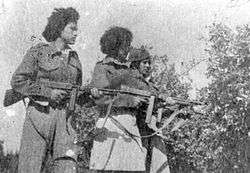
One of the most widely known acts of Lehi was the attack on the Palestinian-Arab village of Deir Yassin.
In the months before the British evacuation from Palestine, the Arab League-sponsored Arab Liberation Army (ALA) occupied several strategic points along the road between Jerusalem and Tel Aviv, cutting off supplies to the Jewish part of Jerusalem. One of these points was Deir Yassin. By March 1948, the road was cut off and Jewish Jerusalem was under siege. The Haganah launched Operation Nachshon to break the siege.
On 6 April, the Haganah attacked al-Qastal, a village two kilometers north of Deir Yassin, also overlooking the Jerusalem-Tel Aviv road.[80]
Then on 9 April 1948, about 120 Lehi and Irgun fighters, acting in cooperation with the Haganah, attacked and captured Deir Yassin. The attack was at night, the fighting was confused, and many civilian inhabitants of the village were killed.[81] This action had great consequences for the war, and remains a cause celebre for Palestinians ever since.
Exactly what happened has never been established clearly. The Arab League reported a great massacre: 254 killed, with rape and lurid mutilations. Israeli investigations claimed the actual number of dead was between 100 and 120, and there were no mass rapes, but most of the dead were civilians, and admitted some were killed deliberately. Lehi and Irgun both denied an organized massacre. Accounts by Lehi veterans such as Ezra Yakhin note that many of the attackers were killed or wounded, assert that Arabs fired from every building and that Iraqi and Syrian soldiers were among the dead, and even that some Arab fighters dressed as women.[82]
However, Jewish authorities, including Haganah, the Chief Rabbinate, the Jewish Agency, and David Ben-Gurion, also condemned the attack, lending credence to the charge of massacre.[83] The Jewish Agency even sent a letter of condemnation, apology, and condolence to King Abdullah I of Jordan.[84]
Both the Arab reports and Jewish responses had hidden motives: the Arab leaders wanted to encourage Palestinian Arabs to fight rather than surrender, to discredit the Zionists with international opinion, and to increase popular support in their countries for an invasion of Palestine. The Jewish leaders wanted to discredit Irgun and Lehi.
Ironically, the Arab reports backfired in one respect: frightened Palestinian Arabs did not surrender, but did not fight either – they fled, allowing Israel to gain much territory with little fighting and also without absorbing many Arabs.[85]
Lehi similarly interpreted events at Deir Yassin as turning the tide of war in favor of the Jews. Lehi leader Israel Eldad later wrote in his memoirs from the underground period that "without Deir Yassin the State of Israel could never have been established".[86][87]
The Deir Yassin story did not much sway international opinion. It did increase, not only support, but pressure on Arab governments to intervene. Abdullah of Jordan was now compelled to join the invasion of Palestine after Israel's declaration of independence on 14 May.
Assassination of Count Folke Bernadotte
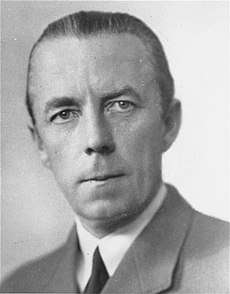
Although Lehi had stopped operating nationally after May 1948, the group continued to function in Jerusalem. On 17 September 1948, Lehi assassinated UN mediator Count Folke Bernadotte. The assassination was directed by Yehoshua Zettler and carried out by a four-man team led by Meshulam Makover. The fatal shots were fired by Yehoshua Cohen. The Security Council described the assassination as a "cowardly act which appears to have been committed by a criminal group of terrorists".[88]
Three days after the assassination, the Israeli government passed the Ordinance to Prevent Terrorism and declared Lehi to be a terrorist organization.[89][90] Many Lehi members were arrested, including leaders Nathan Yellin-Mor and Matitiahu Schmulevitz who were arrested on 29 September.[89] Eldad and Shamir managed to escape arrest.[89] Yellin-Mor and Schmulevitz were charged with leadership of a terrorist organization and on 10 February 1949 were sentenced to 8 years and 5 years imprisonment, respectively.[91][92][93] However the State (Temporary) Council soon announced a general amnesty for Lehi members and they were released.[91][94]
The Lehi trial and the Fighters' Party
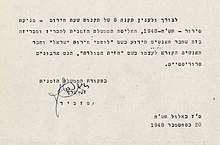
Between 5 December 1948 and 25 January 1949, Yellin-Mor and Schmuelevitch were tried in a military court on terrorism charges.[96] The prosecution accused them of the murder of Bernadotte, though they were not specifically charged with it.[96] Senior officers of the IDF, including Yisrael Galili and David Shaltiel, told the court that Lehi had hindered, rather than assisted the fight against the British and the Arabs.[96]
While the trial was in progress, some of the Lehi leadership founded a USSR-leaning political party called the Fighters' List with Yellin-Mor as its leader.[97] The party took part in the elections in January 1949 with Yellin-Mor and Schmuelevitch heading the list.[97] The trial verdict was handed down on 10 February, soon after the Fighters' List had won one seat with only 1.2% of the vote.[97] Yellin-Mor was sentenced to 8 years and Schmuelevitch to 5 years imprisonment, but the court agreed to remit the sentences if the prisoners agreed to a list of conditions.[97] The Provisional State Council then authorised their pardon.[97] The party disbanded after several years and did not contest the 1951 elections.[98]
In 1956, some Lehi veterans established the Semitic Action movement, which sought the creation of a regional federation encompassing Israel and its Arab neighbors[33][34] on the basis of an anti-colonialist alliance with other indigenous inhabitants of the Middle East.[35]
Not all Lehi alumni gave up political violence after independence: former members were involved in the activities of the Kingdom of Israel militant group, the 1957 assassination of Rudolf Kastner, and likely the 1952 attempted assassination of David-Zvi Pinkas.[99][100][101][102]

Service ribbon
In 1980, Israel instituted the Lehi ribbon, red, black, grey, pale blue and white, which is awarded to former members of the Lehi underground who wished to carry it, "for military service towards the establishment of the State of Israel".[23]
"Unknown Soldiers" anthem
The words and music of a song "Unknown Soldiers" (also translated "Anonymous Soldiers") were written by Avraham Stern in 1932 during the early days of the Irgun. It became the Irgun's anthem until the split with Lehi in 1940, after which it became the Lehi anthem.[103][104][105]
Prominent members of Lehi
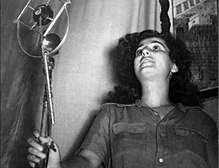
A number of Lehi's members went on to play important roles in Israel's public life.
- Shaltiel Ben-Yair, explosives expert, organised together with Amos Kenan the assassination attempt against the Transportation Minister in 1952[106]
- Eliyahu Bet-Zuri, executed in 1945 for his part in the assassination of Lord Moyne
- Geula Cohen, member of the Knesset
- Israel Eldad, leader in the Israeli national camp
- Boaz Evron, left-wing journalist
- Maxim Ghilan, Israeli journalist, author and peace activist
- Eliyahu Giladi, killed in 1943 by his Lehi comrades because of argueing in favour of committing acts considered too extremist even by them
- Uri Zvi Greenberg, Israeli poet and journalist
- Eliyahu Hakim, executed in 1945 for assassinating Lord Moyne
- Amos Kenan, writer
- Baruch Korff, Orthodox rabbi
- Yitzhak Shamir, Israeli prime minister 1983–1984 and 1986–1992
- Avraham Stern, leader and ideologist
- Shimon Tzabar, Yiddish-language playwright
- Natan Yellin-Mor, member of the Knesset 1949–1951, leftist advocate of peace with Arabs.[107]
See also
- List of Lehi operations
- List of Lehi members
- Hamaas, an official publication of the Lehi
- Jewish insurgency in Palestine
- Roy Farran, letter bomb incident
References
- "סמל לח״י".
- "This group was known to its friends as LEHI and to its enemies as the Stern Gang." Blumberg, Arnold. History of Israel, Westport, CT, USA: Greenwood Publishing Group, Incorporated, 1998. p 106.
- "calling themselves Lohamei Herut Yisrael (LHI) or, less generously, the Stern Gang." Lozowick, Yaacov. Right to Exist : A Moral Defense of Israel's Wars. Westminster, MD, USA: Doubleday Publishing, 2003. p 78.
- "It ended in a split with Stern leading his own group out of the Irgun. This was known pejoratively by the British as "the Stern Gang' – later as Lehi" Shindler, Colin. Triumph of Military Zionism : Nationalism and the Origins of the Israeli Right. London, GBR: I. B. Tauris & Company, Limited, 2005. p 218.
- "Known by their Hebrew acronym as LEHI they were more familiar, not to say notorious, to the rest of the world as the Stern Gang – a ferociously effective and murderous terrorist group fighting to end British rule in Palestine and establish a Jewish state." Cesarani, David. Major Faran's Hat: Murder, Scandal and Britain's War Against Jewish Terrorism, 1945–1948. London. Vintage Books. 2010. p 01.
- "ELIAHU AMIKAM Stern Gang Leader" (Free Preview; full article requires payment.). The Washington Post. 16 August 1995. pp. D5. Retrieved 18 November 2008.
The [AMIKAM] Stern Gang – known in Hebrew as Lehi, an acronym for Israel Freedom Fighters – was the most militant of the pre-state underground groups.
- "Definition of Stern Gang in English". Oxford Dictionaries. Retrieved 30 November 2013.
- Colin Shindler, Triumph of Military Zionism: Nationalism and the Origins of the Israeli Right, I.B.Tauris, 2009 p.218:'Stern devotedly believed that 'the enemy of my enemy is my friend' so he approached Nazi Germany. With German armies at the gates of Palestine, he offered co-operation and an alliance with a new totalitarian Hebrew republic.'
- Laqueur, Walter (2003) [1972]. "Jabotinsky and Revisionism". A History of Zionism (Google Book Search) (3rd ed.). London: Tauris Parke Paperbacks. p. 377. ISBN 978-1-86064-932-5. OCLC 249640859. Retrieved 18 November 2008.
- Nachman Ben-Yehuda. The Masada Myth: Collective Memory and Mythmaking in Israel. Madison, Wisconsin, USA: Wisconsin University Press, 1995. Pp. 322.
- Calder Walton (2008). "British Intelligence and the Mandate of Palestine: Threats to British national security immediately after the Second World War". Intelligence and National Security. 23 (4): 435–462. doi:10.1080/02684520802293049.
- Arie Perliger, William L. Eubank, Middle Eastern Terrorism, 2006 p.37: "Lehi viewed acts of terrorism as legitimate tools in the realization of the vision of the Jewish nation and a necessary condition for national liberation."
- Jean E. Rosenfeld, Terrorism, Identity, and Legitimacy: The Four Waves Theory and Political Violence, 2010 p.161 n.7:'Lehi ... was the last group to identify itself as a terrorist one'
- He Khazit (underground publication of Lehi), Issue 2, August 1943. No author is stated, as was usual for this publication. Translated from original. For a discussion of this article, see Heller, p. 115
- Sasson Sofer. Zionism and the Foundations of Israeli Diplomacy. Cambridge University Press, 2007. Pp. 253-254.
- Leslie Stein, The Hope Fulfilled: The Rise of Modern Israel, Greenwood Publishing Group 2003 pp.237–238.
- Robert S. Wistrich, David Ohana. The Shaping of Israeli Identity: Myth, Memory, and Trauma, Issue 3. London, England, UK; Portland, Oregon, USA: Frank Cass & Co. Ltd., 1995. Pp. 88.
- Joseph Heller. The Stern Gang: Ideology, Politics, and Terror, 1940–1949. Pp. 8.
- Ami Pedahzur, The Israeli Response to Jewish Extremism and Violence: Defending Democracy, Manchester University Press, Manchester and New York 2002 p.77
- Gabriel Ben-Dor and Ami Pedahzur, 'Jewish Self-Defence and Terrorist Groups Prior to the Establishment of the State of Israel: Roots and Traditions,' in Ami Pedahzur, Leonard Weinberg (eds.), Religious Fundamentalism and Political Extremism, Frank Cass, 2004 pp. 94–120, pp. 115–116:'one final terrorist act...'
- Ralph Bunche report on assassination of UN mediator Archived 7 May 2008 at the Wayback Machine 27 September 1948, "notorious terrorists long known as the Stern group"
- Ami Pedahzur, Arie Perliger Jewish Terrorism in Israel, Columbia University Press, 2011 p.28.
- "Awards for military service towards the establishment of the State of Israel". Israeli Ministry of Defense. Archived from the original on 17 April 2006. Retrieved 17 September 2018.
The ribbon is awarded to: All those who were members of the LEHI underground for a term of six months or more, in the period dating from 1940 up until the establishment of the State of Israel ... Presentation of the ribbon began in 1980.
- Colin Shindler (1995). The Land beyond Promise: Israel, Likud and the Zionist dream. I.B. Tauris. p. 22. ISBN 978-1-86064-774-1.
- The Jews: A Contrary People Yehuda Bauer pages 77-78
- Colin Shindler, The Land Beyond Promise: Israel, Likud and the Zionist Dream, I.B. Tauris, 2002, p. 25: 'Stern perceived Hitler as the latest in a long line of anti-Semites who could be won over if the common interest was identified. In Palestine at that time, Stern was not alone in regarding Hitler as a persecutor and not an exterminator. The dream of attaining a Jewish state dominated Zionist thinking and the very idea of the Final Solution was unthinkable in 1940. Stern believed that Hitler wanted Germany to be judenrein through emigration'.
- Ben-Ami, Eliezer “Yehezkel”. "How was the Lehi symbol born?". Freedom Fighters of Israel Heritage Association (FFI-LEHI).
- Heller, p. 112, quoted in Perliger and Weinberg, 2003, pp. 106–107.
- Perliger and Weinberg, 2003, p. 107.
- Bethell Nicholas, The Palestine Triangle: The Struggle between British, Jews, and the Arabs, 1935–48 (1979), page 278
- Amichal, page 316, a copy on the web exists here
- Israel Eldad, The First Tithe, p. 84
- Diamond, James S. (1990). "We Are Not One: A Post-Zionist Perspective". Tikkun. 5 (2): 107.
- Hattis Rolef, Susan. "YELLIN-MOR (Friedman), NATHAN". Encyclopaedia Judaica.
- Beinin, Joel (1998). The Dispersion of Egyptian Jewry: Culture, Politics, and the Formation of a Modern Diaspora. University of California Press. pp. 166
- Heller, 1995, p. 70.
- Perliger and Weinberg, 2003, p. 108.
- The Origins of Israel, 1882–1948: A Documentary History by Eran Kaplan, Derek J. Penslar state that "Lehi's ideology was a strange brew of fascism and communism, racism and universalism" The Origins of Israel, 1882–1948: A Documentary History - Page 274 Eran Kaplan, Derek J. Penslar - 2011
- Amichal, 77
- Jabotinsky and the Revisionist Movement 1925-1948 Yaacov Shavit Routledge; 1 edition 1988) page 231 "Articles in contemporary Lehi publications talked about the Jewish nation as a heroic people, even a 'master race' (in contrast to the Arabs, who were considered a nation of slaves)"
- Sasha Polakow-Suransky, "The Unspoken Alliance: Israel's Secret Relationship with Apartheid South Africa", page 107
- "Religious Fundamentalism and Political Extremism", edited by Leonard Weinberg, Ami Pedahzur, page 112, Routledge 2008
- (in Polish) Jakub Mielnik: Jak polacy stworzyli Izrael Archived 7 April 2009 at the Wayback Machine, Focus.pl Historia, 5 May 2008
- Perliger and Weinberg, 2003, p. 109.
- Boyer Bell, 1996, p. 71.
- N. Ben-Yehuda, Political Assassinations by Jews (State University of New York, 1993), p. 397.
- The Stern Gang: Ideology, Politics and Terror, 1940–1949, Joseph Halper, Routledge page 129
- Masada Myth: Collective Memory and Mythmaking in Israel, Nachman Ben-Yehuda, University of Wisconsin Press, page 143
- Heller, 1995, p. 86.
- Heller, 1995, p. 86
- Nachman Ben-Yehuda (2012). Political Assassinations by Jews: A Rhetorical Device for Justice. SUNY Press. pp. 147–150, 185–188.
- Heller, 1995 p. 86
- Heller, 1995, pp. 78–79.
- Yossi Melman (3 June 2011). "Undermining the underground". Haaretz.
- Yaacov Eliav (1984). Wanted. Shengold Publishers. pp. 144–145.
- "Political Theologies in the Holy Land: Israeli Messianism and its Critics", David Ohana
- David Yisraeli, The Palestine Problem in German Politics, 1889–1945, Bar Ilan University, Ramat Gan, Israel, 1974. Verified web copies: German English. Also see Otto von Hentig, Mein Leben (Goettingen, 1962) pp. 338–339
- Lenni Brenner, Zionism in the Age of the Dictators 2004, p234
- Natan Yellin-Mor, manuscript in English quoted by Lenni Brenner, 51 Documents (Barricade Books, 2002) p. 308.
- Heller (1985) p.85
- A Meeting in Beirut, Habib Canaan, Haaretz (musaf), 27 March 1970
- Heller 1995, p. 91.
- Heller, 1995, p. 91
- "Stern Gang" The Oxford Companion to World War II. Ed. I. C. B. Dear and M. R. D. Foot. Oxford University Press, 2001.
- James Barr, A Line in the Sand: Britain, France and the struggle that shaped the Middle East, Simon and Schuster, 2011 p.255
- The Stern Gang: Ideology, Politics and Terror, 1940-1949 Joseph Heller page 114 "Above all, in the summer of 1943 Lehi had still not broken free from the doctrine of persecutor and enemy'. Even after the extent of the Holocaust was revealed, Lehi refused to depict Hitler rather than England as the main foe."
- Iviansky 1986, 72–73.
- Bell, Bowyer J.: Terror out of Zion (1976)
- Yitzhak Shamir, 'Why the Lehi Assassinated Lord Moyne', Nation, 32/119 (1995) pp. 333–37 (Hebrew) cited in Perliger and Weinberg, 2003, p. 111.
- Israel honours British minister's assassins, The TImes, 26 June 1975, p1.
- "הרוגי מלכות גליונית זכרון - התאחדות בולאי ישראל".
- (detailed)
- Randall David Law, Terrorism: A History, Polity, 2009 p.186.
- Cesarani, David: Major Farran's Hat: The Untold Story of the Struggle to Establish the Jewish State (2009)
- Andrew, Christopher (2009) The Defence of the Realm. The Authorized History of MI5. Allen Lane. ISBN 978-0-7139-9885-6. Page 922. Note 39. Pages 355-359.
- Nachman Ben-Yehuda (2012). Political Assassinations by Jews: A Rhetorical Device for Justice. SUNY Press. p. 331.
- Ira Smith and Joe Alex Morris, Dear Mr President, Julian Messner Inc. New York 1947 p. 230 writes that "the same kind of terrorist letters" which Lehi claimed responsibility for sending to British politicians had been detected in mail to the White House:
- Rosenbaum, Ron. Explaining Hitler: The Search for the Origins of His Evil. p. 63.
- Sand, Shlomo The Invention of the Land of Israel: From Holy Land to Homeland p. 268
- Silver 1984, p. 91.
- Yoav Gelber, Palestine 1948, Appendix II
- Ezra Yakhin (1992), Elnakam, pp. 261–272.
- Yoav Gelber (2006), Palestine 1948, p.317.
- Benny Morris (2003), The Birth of the Palestinian Refugee Problem Revisited, p. 239.
- Benny Morris (2003), The Birth of the Palestinian Refugee Problem Revisited, p. 239. "the most important immediate effect of the atrocity and the media campaign that followed it was how one started to report the fear felt in Palestinian Arab towns and villages, and, later, the panicked fleeing from them."
- Israel Eldad (1950), The First Tithe, pp. 334–335.
- Heller, 1995, p. 209.
- UNSC "Archived copy". Archived from the original on 3 December 2013. Retrieved 30 November 2013.CS1 maint: archived copy as title (link) resolution 57 (18 September 1948).
- Sprinzak, p. 45
- Ami Pedahzur, The Israeli Response to Jewish Terrorism and Violence: Defending Democracy, Manchester University Press, Manchester and New York 2002 p. 77
- Sprinzak, p47
- Heller, p265.
- "LHY leaders get 8,5 years", Palestine Post, 11 February 1949.
- Heller, p267.
- "For the purposes of Regulation 8 of the Emergency Regulations — Prevention of Terrorism — 5748-1948, the Provisional Government has decided to declare that the group of people known as 'Freedom Fighters of Israel' and the members of the so-called 'Homeland Front' are terrorist organizations. By order of the provisional administration. Ze'ev Sharaf (Government Secretary)."
- Heller (1995), pp. 261–266
- Heller (1995), pp. 265–267
- Heller (1995), pp. 279–284
- Baram, Daphna (10 September 2009). "Amos Keinan: Controversial Israeli journalist, writer and artist". The Independent. Retrieved 8 November 2009.
- Melman, Yossi (13 August 2009). "Time bomb". Haaretz. Retrieved 8 September 2009.
- Segev, Tom; Arlen Neal Weinstein (1998). 1949: The First Israelis. Macmillan. pp. 230–231. ISBN 0-02-929180-1.
- Pedahzur, Ami, and Arie Perliger (2009). Jewish Terrorism in Israel. Columbia University Press. p. 31–33
- Zev Golan (2011). Stern: The Man and his Gang. Yair Publishing. pp. 18–19, 81.
- s:Unknown soldiers (song)
- Hayalim Almonim (in Hebrew)
- Melman, Yossi (13 August 2009). "Inside Intel / Time Bomb". Haaretz.
- Washington Report on Middle East Affairs, December 1986, "Portrait of a Mideast Terrorist"
Works cited
- (in Hebrew) Amichal Yevin, Ada (1986). In purple: the life of Yair-Abraham Stern. Tel Aviv: Hadar Publishing House.
- Bell, J. Bowyer (1977). Terror Out of Zion: Irgun Zvai Leumi, Lehi, and the Palestine Underground, 1929–1949. Avon. ISBN 0-380-39396-4
- Ben-Yehuda, Nachman (1998). "Political Violence: Political Assassinations as a Quest for Justice." In Robert R. Friedmann (Ed.). Crime and Criminal Justice in Israel: Assessing The Knowledge base Toward The Twenty-first Century (pp. 139–184). SUNY Press. ISBN 0-7914-3713-2.
- Golan, Zev (2003). Free Jerusalem: Heroes, Heroines and Rogues Who Created the State of Israel. Devora. ISBN 1-930143-54-0
- Golan, Zev (2011). Stern: The Man and His Gang. Yair. ISBN 978-965-91724-0-5
- Heller, J. (1995). The Stern Gang. Frank Cass. ISBN 0-7146-4558-3
- Hyams, Edward (1975) Terrorists and Terrorism ISBN 978-046-00786-3-4
- Iviansky, Z. (1986) "Lechi's Share in the Struggle for Israel's Liberation," in: Ely Tavin and Yonah Alexander (Ed.).Terrorists or Freedom Fighters, Fairfax, Va.: HERO Books.
- Katz, E. (1987). "LECHI: Fighters for the freedom of Israel", Tel Aviv: Yair Publishers
- Lustick, Ian S. (1994). "Terrorism in the Arab–Israeli Conflict: Targets and Audiences." In Crenshaw, Martha (ed). Terrorism in Context (pp. 514–552). University Park, PA: Pennsylvania State University Press. ISBN 0-271-01015-0
- Marton, K. (1994). A Death in Jerusalem. Pantheon. ISBN 0-679-42083-5 — Bernadotte assassination
- Munson, Henry (2005). "Religion and violence". Religion. 35 (4): 223–246. doi:10.1016/j.religion.2005.10.006.
- Perliger, Arie; Weinberg, Leonard (2003). "Jewish Self-Defence and Terrorist Groups Prior to the Establishment of the State of Israel: Roots and Traditions". Totalitarian Movements and Political Religions. 4 (3): 91–118. doi:10.1080/14690760412331326250.
- Ehud Sprinzak (1999). Brother against Brother. The Free Press. ISBN 0-684-85344-2.
External links
| Wikimedia Commons has media related to Lehi (group). |
- lehi.org (in Hebrew)
- British wanted poster from 1940s
